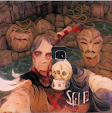This last week I've been involved in something rather new and interesting to me.
Producer-Director Roger Larry approached me about shooting a couple of projects for Canadian artist, Mark Lewis. I said yes of course and soon found myself a cinematographer in the world of art, nay, Art.
Talk about shifting paradigms, it was a revolution for me, a full 360, coming full circle. Back when I was a student filmmaker in the late eighties, Art was all I was interested in. I think of myself from back then and wince at my arrogance. Those of you who know me, if you think I'm unbearable now I was far, far worse then.
Our film school professors wrestled us into narrative filmmaking. We grudgingly accepted film as a story medium, not as Art for museums, art as in craftsmanship. Building houses, not exhibits. The story is the thing. Great cinematography supports the story, you're a base player, a backup singer. You may be called upon to solo, but generally you're supposed to disappear into the background.
Anyway... I gradually evolved to the point of making movies as crowd pleasers. Emotional rollercoasters. Definitely Art with a little 'a'. I mean: INSECTICIDAL. Really.
On my last show, GOBLIN, I literally scoffed at the idea of doing anything artistic. 'Big A-Art has no place on this set' I practically proclaimed to cinematographers Tom Harting and previously Andy Strahorn (HOUSE OF BONES).
All this to communicate how refreshing participating in the making of an Art film was for me. It was all about that one shot. Getting it perfect. Taking whatever time it takes, returning to the scene if necessary. All about just one shot.
It had little to do with how I saw Art back when I started. When you're looking for perfection, beauty, the ego disappears just as it does (perhaps more so) when it bows away for the needs of the story.
Two separate projects, two shots then. That we worked on over a week. Then there was the technical nature of the shots, truly poetic from my perspective. You'll soon see why.
One of the shots was a traditional technical challenge: a rear screen plate, day-for-night on the water. Shot in black and white 35mm.
I love this sort of thing, Panavision supplied us with a 535B and a couple of primes, an assortment of heavy 6x6 grads, a polarizer, classic B&W filters (Red and Orange, a little hard to find nowadays) etc... The idea was to paint the shot entirely in camera and do a classic photochemical post workflow, they'll project the plate behind the actors in Toronto and Mark Lewis will reshoot it there.
Hardly anyone processes 35mm B&W anymore, but I was happy to hear that my old ally: Alpha Cine in Seattle still offers the service (and with gray-haired guys at the tiller too!). We used to ship them our S8 and S16mm B&W negative all the time back when I got started.
The other shot was a portrait of a specific spot in downtown Vancouver where people have been showing up and dancing night after night. We ended up shooting that with a dslr, a Canon 1D Mark iv for it's amazing low-light capability.
I love this sort of thing too. Using a bleeding-edge camera system, learning it's intricacies.
Because we weren't able to source a PL-mount adapter we ended up renting primes from a photo place (Canon-PL adapters are still rare and hard to get to, also some companies -like Panavision- won't rent them out even if they have them - draw your own conclusions as to why).
And ended up with an out of focus shot! Embarrassingly I'd figured that I didn't need an AC as the shoot was so simple (a static DSLR with a wide angle prime). However, it rained, and I failed to protect the lens sufficiently. There was a fine mist on it that I figured would have little effect on the image other than a slight diffusion. It had looked fine on my SmallHD monitor, but back in the suite, it was obvious that everything was soft. Ugh.
When we returned to reshoot. I also discovered how hard it can be to focus an extreme wide shot with a dslr. Modern-day still camera lenses are all autofocus of course. In order to save on battery power as well as speed up the autofocusing of a shot, the lens is designed so that the markings are all compressed: it needs to move very slightly for focus to go from 15' to 30'. Solution? You MUST magnify x10 to find your focus, and the slightest nudge will throw it way out.
Conclusion regarding further shooting with a DSLR? Either use a PL-mount with a cine-lens OR possibly use old, manual focus lenses.
And so it was that in the course of a week, I ended up shooting in two fringe formats, one ancient and expired, the other so new that we're still discovering how to use it.
That was my week, dealing with The art of Art.
Thursday, April 8, 2010
Subscribe to:
Comments (Atom)
